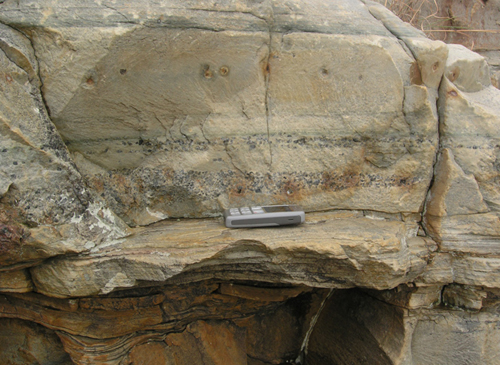In addition to searching out evidence for Archean microbial mats, my revisitation of the Pongola sandstones gave me the chance to look a bit more closely at their lithology. When I last posted pictures from this sequence, there was a bit of discussion about why the beds appeared to be quite dark – sandstones are generally lighter in colour (being composed mainly of quartz). Is this due to some weird mineralogy? Or just an effect of modern day weathering?
Here’s a close-up of one of the dark beds:

It does appear that the dark colour does indeed seem to be a result of minerals actually in the rock, rather than formed by weathering on the surface. However, I’m still not sure what these minerals are; presumably there’s just enough squeezed in between this quartzite’s cemented quartz grains to change it’s optical properties. You’d probably have to make a thin section to know for sure what they are – any guesses?
A bit further up section, you find much more familiar-looking, pale quartzites:

Two things of interest here*. Firstly, the appearance of much coarser gravel-rich horizons indicates a more high energy environment: stronger currents are afoot that can move around larger sediment grains. Secondly, just as in the first picture, there are numerous squarish holes surrounded by rusty weathering halos, which mark the former location of iron-rich minerals that have now been oxidised. From their shape, I suspect that these were detrital pyrite grains, which are one of the bits of evidence for an anoxic atmosphere in the Archean; it is only in a reducing, anoxic atmosphere that pyrite can be eroded, transported, and redeposited, rather than being chemically destroyed as it has been on exposure to the modern elements. The fact that these pyrites occur in both in the pale and the dark quartzites seems to rule out weird anoxic geochemistry as the explanation for the latter. Perhaps the stronger currents evident in the light quartzites have just winnowed away any darker minerals.
*Other than the use of my mobile phone as a scale bar. And the primitive nature of said phone.



Comments (7)